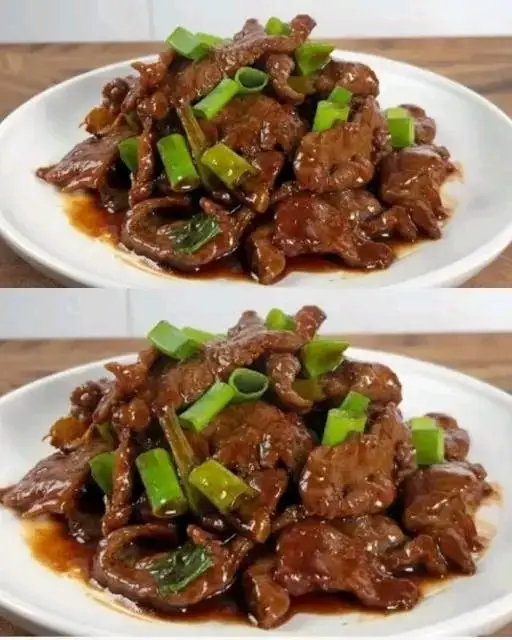Restaurant-worthy tenderness, using inexpensive cuts and a simple marinade.
When we try beef in a good Chinese restaurant, the feeling is always the same: incredible tenderness, juiciness and just the right amount of flavor
It’s not about premium cuts or special equipment, but about a centuries-old technique called velveting — a “velvetizing” of protein that breaks down fibers, seals in moisture, and creates that silky texture.
The good news? You can replicate this in your kitchen in less than an hour.
Why Does It Work?
- Baking soda breaks protein bonds, softening the fibers.
- Cold water hydrates the meat and helps to “inflate” the fibers, leaving the cut elastic.
- Egg whites create a protective film that holds in the juices.
- Cornstarch forms a second layer, sealing everything when it encounters heat.
Combined, these steps transform even lean, inexpensive cuts into tender pieces—perfect for quick stir-fries, accompanied by vegetables and aromatic sauces.
Ingredient Checklist
(Serves 3 to 4 people as a main course)
Meat & Marinade
- 900g lean beef (rump, flank or chuck heart)
- 1 ½ teaspoons baking soda
- 1 ½ teaspoons sugar
- 1 teaspoon of fine salt
- 360 mL very cold water (divide into 4–5 additions)
- 1 egg white
- 3 heaped tablespoons of cornstarch
- 1 tablespoon of oil (to “unstick” when sealing)
Final Sauce
- 1 tablespoon of light soy sauce
- ¼ teaspoon sugar
- 1 teaspoon dark soy sauce (color)
- 1 tablespoon of red wine
- 1/8 teaspoon white pepper
- 2 tablespoons of water
- 1 teaspoon cornstarch (dissolved in water)
Aromatics & Oil
- Ginger – 3 thin slices
- Garlic – 2 cloves, sliced
- Scallions – sliced white part + chopped green part to finish
- Vegetable oil (soybean, canola or peanut) as needed
Step by Step (Execution Checklist)
- Slicing the Meat
- Lightly freeze the piece for 1 hour to firm up.
- Cut into smaller pieces, then slice against the grain into 2–3 mm thick strips. The thinner the strip, the faster it cooks.
- Marinate & Velvetize
-
- In a large bowl, combine baking soda, sugar, salt, MSG, and ¼ of the ice water . Add the meat.
- Mix with your hands until it becomes sticky . Add the remaining water in 3–4 batches, massaging well before each addition.
- Add the egg white and mix well.
- Sprinkle in the cornstarch and mix just until the powder disappears.
- Cover and let rest for 30 minutes at room temperature. There should be no liquid left at the bottom—a sign of a perfect marinade.
- Finally, mix in 1 tablespoon of oil to prevent the strips from sticking together during sealing.
-
- Split & Store
- Separate the meat into portions for immediate use.
- Vacuum pack the rest or put it in a zip lock bag, keeping it for 3 days in the refrigerator or 15 days in the freezer without losing texture.
- Mix the Sauce
- In a small bowl, combine soy sauce, sugar, white pepper, wine, oyster sauce, water, and cornstarch . Set aside. This will add color and shine.
- Seal the Meat
- Heat 2 tablespoons of oil in a wok or large skillet over high heat.
- Spread the meat in a single layer. Don’t stir until the bottom changes color.
- Flip, sear the other side until 70–80% done (still pink inside). Remove and drain.
- Sauté Aromatics
- In the same pan (without washing), add a little more oil if necessary.
- Sauté ginger until fragrant, then garlic and the white part of the spring onion.
- Finish the Stir-fry
- Return the meat to the wok.
- Pour in the sauce and sauté over high heat for 30–40 seconds , until thickened and coated.
- Add the chopped green onion , stir twice more and turn off the heat.
- Serve
- Transfer immediately to a warmed plate. Serve with white rice, steamed vegetables, or rice noodles.
Extra Tips
- Lean cuts are ideal : less surface fat, more contact area to absorb the marinade.
- Cold water is crucial for hydration; warm water “cooks” the surface and gets in the way.
- No soy sauce in the main marinade : the premature color prevents you from seeing the real point of the meat while searing.
- Steaming wok : the higher the temperature, the faster the starch forms the protective film.
Variations & Combos
| Idea | Adjustment |
|---|---|
| Meat with broccoli | Sauté blanched florets in place of ginger/garlic before returning the meat. |
| Colorful bell pepper | Add strips of bell pepper after the aromatics and follow the recipe. |
| Spicy touch | Add ½ teaspoon of doubanjiang chili paste along with the sauce. |
| Glutamate-free version | Eliminate the MSG and add ½ teaspoon of oyster sauce for extra body. |
In short
With affordable cuts, a clever marinade, and intense heat, you can bring home the “silk effect” that makes meat famous in Chinese restaurants.
The texture changes, the flavor deepens, and the dish is ready in minutes. Try this technique at your next dinner party and see how simple, economical, and deliciously surprising Asian cuisine can be.
Happy cooking — and until the next recipe!

